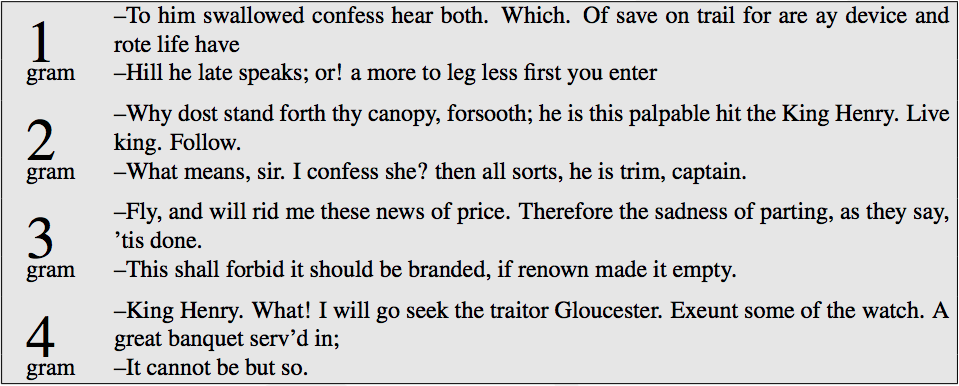CSC413 Neural Networks and Deep Learning
Lecture 3
Lecture Plan
Last week:
- From linear models to multilayer perceptrons
- Backpropagation to compute gradients efficiently
Lecture Plan II
This week:
- First hour:
- automatic differentiation
- Second hour:
- distributed representations
- GloVe embeddings
Both will be helpful for Assignment 1
Automatic Differentiation (Autodiff)
Derivatives in Machine Learning
The machine learning approach requires the minimization of some cost/loss function, which is often done using some variation of gradient descent. \[\theta \leftarrow \theta - \alpha\frac{\partial \mathcal{E}}{\partial \theta}\]
Derivatives in Machine Learning
\[\theta \leftarrow \theta - \alpha\frac{\partial \mathcal{E}}{\partial \theta}\]
Approaches to computing derivatives:
- Manually working out derivatives
- Numeric differentiation (using finite difference approximations)
- Symbolic differentiation (using expression manipulation)
Derivatives in Machine Learning
\[\theta \leftarrow \theta - \alpha\frac{\partial \mathcal{E}}{\partial \theta}\]
Approaches to computing derivatives:
Numeric differentiation (using finite difference approximations)
Symbolic differentiation (using expression manipulation)
- Automatic differentiation or algorithmic differentiation
Terminology
- Automatic differentiation: convert the program into a sequence of primitive operations, which have specified routines for computing derivatives.Then, we can compute gradients in a mechanical way via the chain rule.
- Also used in computational fluid dynamics, atmospheric sciences, etc.
- Backpropagation: special case of autodiff where the program is a neural network forward pass.
- Autograd, JAX, PyTorch, TensorFlow are examples of particular implementations of autodiff, i.e. different libraries
Backpropagation
Steps:
- Convert the computation into a sequence of primitive operations
- Primitive operations have easily computed derivatives
- Build the computation graph
- Perform a forward pass: compute the values of each node
- Perform the backward pass: compute the derivative of the loss with respect to each node
Autodiff, more generally
We will discuss how an automatic differentiation library could be implemented
- build the computation graph
- vector-Jacobian products (VJP) for primitive ops
- perform the backward pass
You will probably never have to implement autodiff yourself but it is good to know its inner workings!
Autodiff, more generally
Key Insight: For any new deep learning model that we can come up with, if each step of our computation is differentiable, then we can train that model using gradient descent.
Scalar Example
Notation: \(x\) is the input, \(y=f(x)\) is the output, we want to compute \(\frac{dy}{dx}\)
Scalar Example
Automatic Differentiation Steps:
- convert the computation into a sequence of primitive operations
- we need to be able to compute derivatives for these primitive operations
- build the computation graph
- perform forward pass
- perform backward pass
Scalar Example: Primitive Ops
Operations:
Scalar Example: Computation Graph
Exercise: Draw the computation graph:
Based on the computation graph, we can compute \(\frac{dy}{dx}\) via a forward and a backward pass.
Vector Inputs and Outputs
More generally, input/output to a computation may be vectors
def f(a, w): # a and w are both vectors with size 10
h = a
for i in range(3):
h = np.dot(w, h) + h
z = w * h # element wise multiplication
return zSo we have \(\bf{y} = f(\bf{x})\) (in this example, \(\bf{x}\) consists of values in both a and w)
Q: In our running example, what are the dimensions of \({\bf x}\) and \({\bf y}\)?
The Jacobian Matrix
We wish to compute the gradients \(\frac{\partial y_k}{\partial x_i}\) for each \(k\) and \(i\), at some \(\bf{x}\).
In other words, we would like the to work with the Jacobian matrix
\[\begin{align*} J_f({\bf x}) &= \begin{bmatrix} \frac{\partial y_1}{\partial x_1}({\bf x}) & \ldots & \frac{\partial y_1}{\partial x_n}({\bf x}) \\ \vdots & \ddots & \vdots \\ \frac{\partial y_m}{\partial x_1}({\bf x}) & \ldots & \frac{\partial y_m}{\partial x_n}({\bf x}) \end{bmatrix} \end{align*}\]
The Jacobian Matrix
\[\begin{align*} J_f({\bf x}) &= \begin{bmatrix} \frac{\partial y_1}{\partial x_1}({\bf x}) & \ldots & \frac{\partial y_1}{\partial x_n}({\bf x}) \\ \vdots & \ddots & \vdots \\ \frac{\partial y_m}{\partial x_1}({\bf x}) & \ldots & \frac{\partial y_m}{\partial x_n}({\bf x}) \end{bmatrix} \end{align*}\]
Note that we usually want to avoid explicitly constructing the entries of this Jacobian one by one.
Why? Computing all the partial derivatives one by one is expensive, even with backprop.
Decomposing Into Primitive Operations
Suppose \(f = f_2 \circ f_1\), so we have the computations \({\bf y} = f_2 \circ f_1(\bf{x})\), or in other words: \[\begin{align*} {\bf z} &= f_1(\bf{x}) \\ {\bf y} &= f_2(\bf{z}) \end{align*}\]
If \(f_1\) and \(f_2\) are primitive operations with simple Jacobians, we can apply the Jacobian chain rule:
\[J_{f_2 \circ f_1}({\bf x}) = J_{f_2}({\bf z})J_{f_1}({\bf x})\]
Autodiff, more generally
This video explains the different ways to automatically compute derivatives:
https://www.youtube.com/watch?v=wG_nF1awSSY
- manual
- finite differences
- symbolic differentiation
- autodiff (forward-mode and reverse-mode differentiation)
- how to avoid computing Jacobians one by one
Avoiding Jacobian Products
In practice, computing entries of Jacobians one by one is expensive and we try to avoid it:
- If the dimension of \({\bf y} = f({\bf x})\) is small, use reverse-mode automatic differentiation
- If the dimension of \({\bf x}\) is small, use forward-mode automatic differentiation
Q: Which of these two cases apply to deep learning most often?
Reverse-Mode Automatic Differentiation
Suppose \({\bf y}\) is a scalar, and represents the loss \(\mathcal{L}\) that we wish to minimize. \[\begin{align*} {\bf z} &= f_1(\bf{x}) \\ \mathcal{L} &= f_2(\bf{z}) = {\bf y} \in \mathbb{R} \end{align*}\]
Then we have:
- \(\overline{z} = \frac{\partial \mathcal{L}}{\partial z} = J_{f_2}(\bf{z})^\top\)
- Since \(\overline{x_j} = \sum_i \overline{z_i} \frac{\partial z_i}{\partial x_j}\)
Reverse-Mode Automatic Differentiation
- … we have \(\overline{\bf x}^\top = \overline{\bf z}^\top J_{f_1}(\bf{x})\)
- … which is a vector-Jacobian product
Summary: For each primitive operation, we don’t need to be able to compute entire Jacobian matrix. We need to be able to compute the vector-Jacobian product.
Vector Jacobian Products
For each primitive operation, we must specify the VJPs for each of its arguments
The VJP function should takes in the output gradient (i.e. \({\bar y}\)), the answer (\(y\)), and the arguments (\(x\)), and returns the input gradient (\({\bar x}\)). Here are some examples from https://github.com/mattjj/autodidact/blob/master/autograd/numpy/numpy_vjps.py
defvjp(anp.negative, lambda g, ans, x: -g)
defvjp(anp.exp, lambda g, ans, x: ans * g)
defvjp(anp.log, lambda g, ans, x: g / x)
defvjp(anp.add, lambda g, ans, x, y : unbroadcast(x, g),
lambda g, ans, x, y : unbroadcast(y, g))
defvjp(anp.multiply, lambda g, ans, x, y : unbroadcast(x, y * g),
lambda g, ans, x, y : unbroadcast(y, x * g))
defvjp(anp.subtract, lambda g, ans, x, y : unbroadcast(x, g),
lambda g, ans, x, y : unbroadcast(y, -g))Backprop as Message Passing
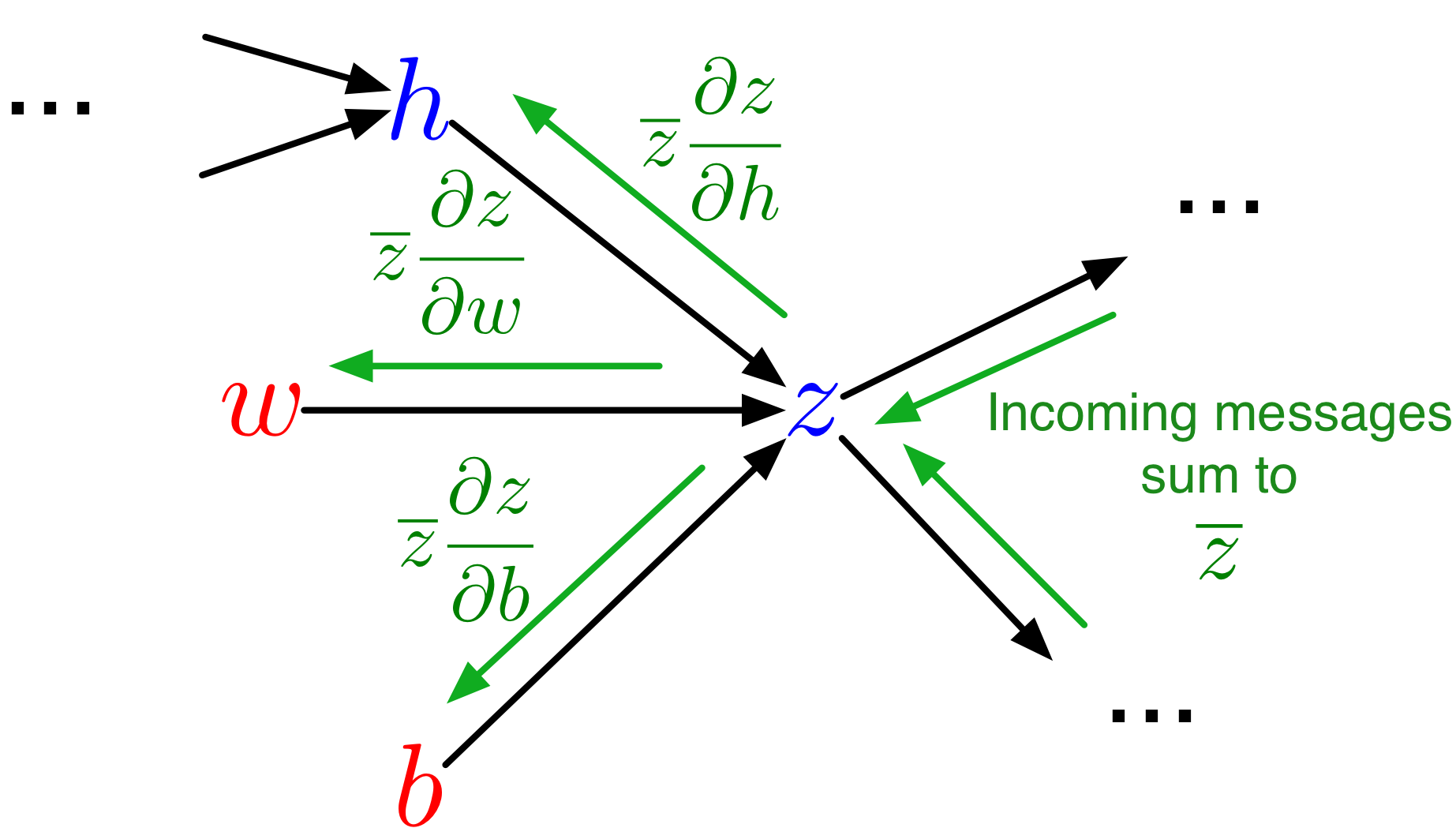
- Each node in the computation graph receives messages from its children, which it aggregates to compute its error signal
- Messages then get passed to its parents
- Each message is a VJP
Backprop as Message Passing
This design provides modularity! Each node needs to know how to compute its outgoing messages, i.e. the VJPs corresponding to each of its parents (arguments to the function).
Differentiable Programming
Recall the key insight from earlier: For any new deep learning model that we can come up with, if each step of our computation is differentiable, then we can train that model using gradient descent.
Example: Learning to learning by gradient descent by gradient descent https://arxiv.org/pdf/1606.04474.pdf
With AD, any program that has differentiable components can be optimized via gradient descent
Distributed Representations
Feature Mapping
- Learning good representations is an important goal in machine learning
- These representations are also called feature mappings, or embeddings
- The representations we learn are often reusable for other tasks
- Finding good representations is an unsupervised learning problem!
Feature Mapping
- Assignment 1:
- Learn vector representations of words: unsupervised learning
- Sometimes also referred to as self-supervised learning
Language Modeling
A language model…
- Models the probability distribution of natural language text.
- Determine the probability \(p({\bf s})\) that a sequence of words (or a sentence) \({\bf s}\) occurs in text.
A language model gives us a way to compute \(p({\bf s})\)
Why Language Models \(p({\bf s})\)?
- Determine authorship:
- build a language model \(p({\bf s})\) of Shakespeare
- determine whether a script is written by Shakespeare
- Generate a machine learning paper (given a corpus of machine learning papers)
Why language models \(p({\bf s})\)?
- Use as a prior for a speech recognition system \(p({\bf s} | {\bf a})\), where \({\bf a}\) represents the observed speech signal.
- An observation model, or likelihood, represented as \(p({\bf a} | {\bf s})\), which tells us how likely the sentence \({\bf s}\) is to lead to the acoustic signal \({\bf a}\).
- A prior, represented as \(p({\bf s})\) which tells us how likely a given sentence \({\bf s}\) is. For example, “recognize speech” is more likely than “wreck a nice beach”
Why language models \(p({\bf s})\)?
- Use as a prior for a speech recognition system \(p({\bf s} | {\bf a})\), where \({\bf a}\) represents the observed speech signal.
- Use Bayes rule to infer a posterior distribution over sentences given the speech signal: \[p({\bf s} | {\bf a}) = \frac{p({\bf s}) p({\bf a} | {\bf s})}{\displaystyle \sum_{{\bf s^\prime}} p({\bf s^\prime})p({\bf a} | {\bf s^\prime})}\]
Training a Language Model
Assume we have a corpus of sentences \({\bf s}^{(1)}, \ldots, {\bf s}^{(N)}\)
The maximum likelihood criterion says we want our model to maximize the probability that our model assigns to the observed sentences. We assume the sentences are independent, so that their probabilities multiply.
Training a Language Model
In maximum likelihood training, we want to maximize \[\prod_{i=1}^N p\left({\bf s}^{(i)}\right)\]
Or minimize: \[-\sum_{i=1}^N \log p\left({\bf s}^{(i)}\right)\]
Since \(p({\bf s})\) is usually small, \(-\log p({\bf s})\) is reasonably sized, and positive.
Probability of a sentence
A sentence is a sequence of words \(w_1, w_2, \ldots, w_T\), so \[\begin{align*} p({\bf s}) &= p(w_1, w_2, \ldots, w_T) \\ &= p(w_1)p(w_2 | w_1) \ldots p(w_T | w_1, w_2, \ldots, w_{T-1}) \end{align*}\] We can make a simplifying Markov assumption that the distribution over the next word depends on the preceding few words.
Probability of a sentence
In assignment 1, we use a context length of 3 and model: \[\begin{align*} p(w_t | w_1, w_2, \ldots, w_{t-1}) = p(w_t | w_{t-3}, w_{t-2}, w_{t-1}) \end{align*}\]
This is a self-supervised learning problem!
N-Gram Language Model
A simple way of modeling \(p(w_t | w_{t-2}, w_{t-1})\) is by constructing a table of conditional probabilities:
Where the probabilities come from the empirical distribution: \[p(w_3 = {\rm cat} | w_1 = {\rm the}, w_2 = {\rm fat}) = \frac{{\rm count}({\rm the\ fat\ cat})}{{\rm count}({\rm the\ fat})}\]
The phrases we’re counting are called n-grams (where n is the length), so this is an n-gram language model. (Note: the above example is considered a 3-gram model, not a 2-gram model!)
Example: Shakespeare N-Gram Language Model
Problems with N-Gram Language Model
- The number of entries in the conditional probability table is exponential in the context length.
- Data sparsity: most n-grams never appear in the corpus, even if they are possible.
Problems with N-Gram Language Model
Ways to deal with data sparsity:
- Use a short context (but this means the model is less powerful),
- Smooth the probabilities, e.g. by adding imaginary counts,
- Make predictions using an ensemble of n-gram models with different \(n\)s.
Local vs Distributed Representations
Conditional probability tables are a kind of local representation: all the information about a particular word is stored in one place: a column of the table.
But different words are related, so we ought to be able to share information between them.
Local vs Distributed Representations
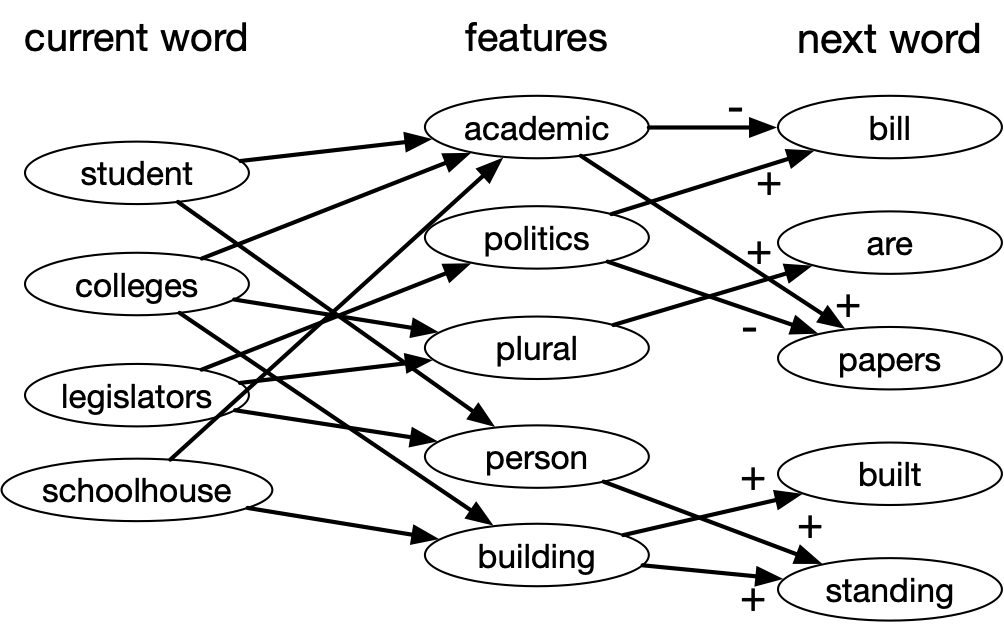
Distributed Representations: Word Attributes
Idea:
- use the word attributes to predict the next word.
- learn the word attributes using an MLP with backpropagation
Sharing Information
Distributed representations allows us to share information between related words. E.g., suppose we’ve seen the sentence
The cat got squashed in the garden on Friday.
This should help us predict the words in the sentence
The dog got flattened in the yard on (???)
An n-gram model can’t generalize this way, but a distributed representation might let us do so.
Neural Language Model
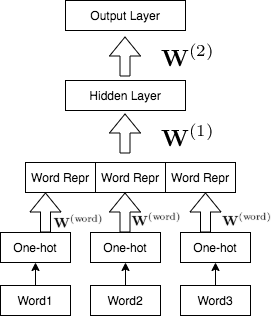
Word Representations
Since we are using one-hot encodings for the words, the weight matrix of the word embedding layer acts like a lookup table.
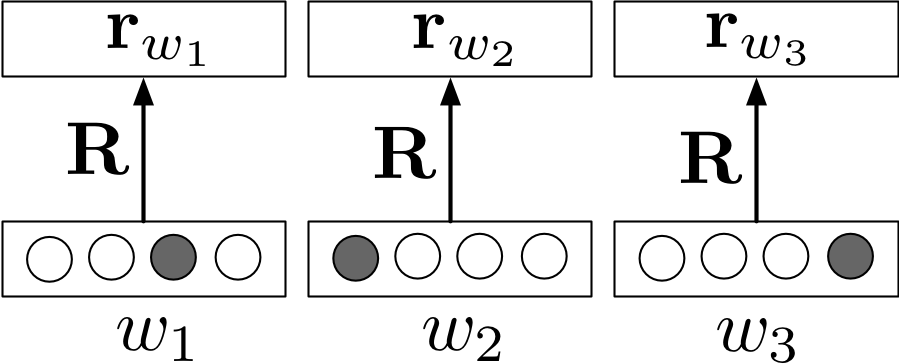
Word Representations
Terminology:
- “Embedding” emphasizes that it’s a location in a high-dimensional space; words that are closer together are more semantically similar.
- “Feature vector” emphasizes that it’s a vector that can be used for making predictions, just like other feature mappings we’ve looked at (e.g. polynomials).
What do Word Embeddings look like?
It’s hard to visualize an \(n\)-dimensional space, but there are algorithms for mapping the embeddings to two dimensions.

In assignment 1, we use algorithm called tSNE, which tries to make distances in the 2-D embedding match the original high-dimensional distances as closely as possible.
A note about these visualizations
- Thinking about high-dimensional embeddings
- Most vectors are nearly orthogonal (i.e. dot product is close to 0)
- Most points are far away from each other
- “In a 30-dimensional grocery store, anchovies can be next to fish and next to pizza toppings” - Geoff Hinton
A note about these visualizations
- The 2D embeddings might be fairly misleading, since they can’t preserve the distance relationship from a higher-dimensional embedding. (Unrelated words might be close together in 2D but far apart in 3D)
GloVe Embeddings
GloVe
- Fitting language models is really hard
- It’s really important to make good predictions about relative probabilities of rare words
- Computing the predictive distribution requires a large softmax
GloVe
- Maybe this is overkill if all you want is word representations
- Global Vector (GloVe) embeddings are a simpler and faster approach based on a matrix factorization similar to principal component analysis (PCA)
Idea: First fit the distributed word representations using GloVe, then plug these embeddings into a neural net that does some other task (e.g. translation)
The Distributional Hypothesis
Distributional Hypothesis: Words with similar distributions have similar meaning
Consider a co-occurrence matrix \(X\), which counts the number of times the words appear nearby (say, less than 5 positions apart)
This is a \(V \times V\) matrix, where \(V\) is the vocabulary size.
Co-occurrence Matrix
Sentence:
The cat got squashed in the garden on Friday. The dog got flattened in the yard on Thursday.
Co-occurrence Matrix
Part of the co-occurrence matrix:
| the | cat | dog | got | squashed | |||
|---|---|---|---|---|---|---|---|
| the | 0 | 1 | 0 | 1 | 0 | ||
| cat | 1 | 0 | 0 | 1 | 1 | ||
| dog | 1 | 0 | 0 | 1 | 0 | ||
| got | 2 | 1 | 1 | 0 | 1 | ||
| squashed | 0 | 1 | 1 | 1 | 0 |
GloVe Embedding Training
Key insight: The co-occurrence matrix of words contain information about the semantic information (meaning) of words

In particular, the ratio of co-occurrences encodes semantic information!
Intuition Pump
Suppose we fit a rank-K approximation
\[{\bf X} \approx {\bf R}{\bf \hat{R}}^\top\]
Where \({\bf R}\) and \({\bf \hat{R}}\) are \(V \times K\) matrices
- Each row \({\bf r}_i\) of \({\bf R}\) is the K-dim representation of a word.
- Each entry of \({\bf X}\) is approximated as \(x_{ij} \approx {\bf r}_i^T {\bf \hat{r}}_j\)
- Minimizing the squared Frobenius norm of the \(\left|\left|{\bf X} - {\bf R}{\bf \hat{R}}^\top\right|\right|_F^2\) is basically PCA
- There are some other tricks to make the optimization work
GloVe Embeddings
Pre-trained models are available for download:
https://nlp.stanford.edu/projects/glove/
Practitioners often use these embeddings to do other language modeling tasks.
GloVe Embedding Demo
Demo on Google Colab
https://colab.research.google.com/drive/1aNbE6HcawVF67RV0hWi4qK33Um7cKykr?usp=sharing
Key idea from the Demo
- Distances are somewhat meaningful, and are based on word co-occurrences
- the words “black” and “white” will have similar embeddings because they co-occur with similar other words.
- “cat” and “dog” is more similar to each other than “cat” and “kitten” because the latter two words occur in different contexts!
Key idea from the Demo
- Word Analogies: Directions in the embedding space can be meaningful
- “king” - “man” + “woman” \(\approx\) “queen”
- Bias in Word Embeddings (and Neural Networks in General)
- neural networks pick up pattern in the data
- these patterns can be biased and discriminatory
Bias and Fairness
Word embeddings are inherently biased because there is bias in the training data.
Neural networks learn patterns in the training data, so if the training data contains human biases, then so will the trained model! This effect was seen in:
